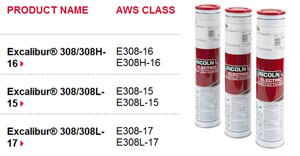Stainless Steel Electrodes: “H” Versus “L” and Coating Types
Q: I have a new fabrication project for furnace racks made with 304H stainless steel and the specifications say to weld it with an E308H electrode. However, I already have some E308/E308L stick electrodes and want to know if I can use those instead? What is the difference between 308, 308L and 308H? I actually have two brands of E308 / E308L electrodes, one type has a “-16” after the 308 numbers and the other has a “-17”. What do those mean?
A: First, note that an American Welding Society (AWS) E308 classification electrode is meant for welding Austenitic types of stainless steel. Therefore, this article will only address this type. While Austenitic stainless steels are very common, there are also Ferritic, Martensitic, Duplex and Precipitation Hardening types of stainless steels.
The answer to your first question is no, an E308 / E308L stainless steel electrode is not meant for use on an AISI type 304H base metal. You do need to use an E308H electrode. The reason why will be explained shortly. Regarding your second question, “308” is a particular type of stainless steel. It is typically used to make welding electrodes and used to join common types of austenitic stainless steels, such as 301, 302, 304 and 305. The “H” and “L” designators indicate a specific composition of the electrode. More specifically, they refer to the carbon percentage in the electrode, with “H” electrodes in the high end and “L” electrodes in the low end of the electrode’s carbon range. An E308 type stainless steel electrode must have a maximum of 0.08% by weight of carbon (C). An E308H electrode however, must have at least 0.04%C, up to a maximum of 0.08% C. Carbon content in the range of 0.04 – 0.08% provides higher tensile and creep strengths at elevated temperatures. They are primarily used in industrial equipment at high service temperatures (sometimes over 2,000°F (1,093°C). Therefore, an E308H electrode would be the appropriate choice for your furnace rack project. Conversely, an E308L electrode can have no more than 0.04% C. The “L” type electrodes are sometimes referred to as “ELC” (extra low carbon) types. The lower carbon content helps minimize the damaging effects to the corrosion resistance of the heat affected zone (i.e. sensitization) caused by intergranular carbide precipitation. They are most often used for weldments that operate in severe corrosive conditions at temperatures under 800°F (427°C)
Note that a particular electrode could, and often is, dual classified. It could be classified as E308 / E308L or as E308 / E308H. The 308 grade has a broader carbon range, so if a particular electrode’s carbon content falls within the tighter L or H carbon level requirements, it also meets the more general 308 requirement. However, you could never have an E308L / E308H classified electrode, as one electrode could never have a carbon content that fits within both the low and high end of the carbon range. Note also that the “H” and “L” carbon designators can apply to other types of austenitic stainless steels besides E308. Some examples include E309H, E309L, E310H, E316H, E316L, etc.
Your third question refers to the type of coatings that are available for stainless steel shielded metal arc (stick) electrodes. There are three types of coating, a “15”, “16” and “17”. A “15” electrode has a lime based coating and is intended for DC+ polarity only. They have a lighter slag than the other two types and used for all position welding, with some electrodes of this type used primarily for vertical down welding. A “16” electrode has a titania or rutile based coating and can be used with both DC and AC polarity. Electrode sizes of 5/32 in. (4.0 mm) and smaller are often used for all welding positions. Note, there is also a “26” classification, which is the same as a “16” type coating, but for higher deposition applications and limited to the flat and horizontal position only. A “17” electrode has a silica-titania type coating and is a modification of a 16 coating, in that some of the titania is replaced with silica. They also can be used with both DC and AC polarity. Additional silicon in the coating acts as a wetting agent, having the effect of increasing puddle fluidity. This is particularly helpful with stainless steel, as it tends to have more of a sluggish weld bead than carbon steel. Seventeen type electrodes produce a flatter bead profile than the other two types and are often used for flat and horizontal position welding. However, electrode sizes of 5/32 in. (4.0 mm) and smaller can be used for all position welding. Note that with a vertical up progression, the slower freezing slag will require more of a weave technique than with a 16 type electrode.

